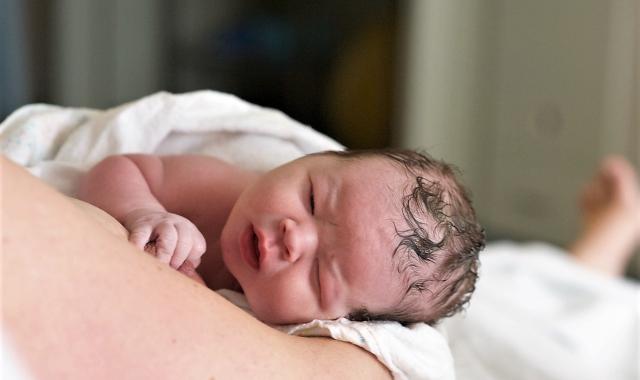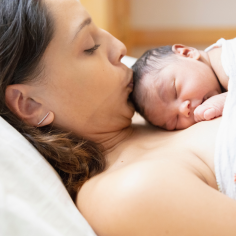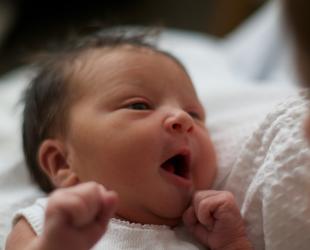When human babies are born, they know by instinct how to make their own way to the breast, attach and start sucking.

Following the birth, have your baby placed directly on your abdomen or chest. This ‘skin-to-skin contact’ is important for your baby and for you.
How skin-to-skin contact helps your baby to attach
For the first breastfeed, your baby will find your breast through a sense of smell. If your baby's hands remain unwashed, they will still have the scent of amniotic fluid on them. This can help your baby find your nipple which has a similar scent.
If you are able, lie in a semi-reclined position, with pillows behind you if you need them. You need to feel well-supported and comfortable as you may be in that position for a while. Having the sides of the hospital bed raised will help you feel more secure.
Continue skin-to-skin contact with your baby as long as you can. This is still possible even when you are being moved from a theatre bed to a recovery bed. Weighing, measuring and bathing baby can be delayed, as can receiving cuddles from family members.
If skin-to-skin needs to be interrupted for medical reasons relating to you, skin-to-skin with another adult, for example your partner, is the next best option.
Skin-to-skin contact is a very important part of successful positioning and attachment since it allows for a baby's natural behaviour - to slowly move and find their way to the breast.
While you and your baby spend time skin-to-skin, observe your baby's movements as they prepare to breastfeed. Many babies are in a quiet, alert state straight after birth so this helps them to follow their instincts.
Signs of readiness to breastfeed – feeding cues
When your baby is ready to feed, they will display instinctive behaviours which prepare them for attaching to the breast and feeding. By noticing these early cues, you can put your baby to the breast while they are still in a calm state.
Your baby will start to display some of these signs as well as be moving about searching for the breast. Babies often suck their fingers, wet the breast, areola and nipple area with their fingers, lick or nuzzle the breast for some time before being ready to attach. They might bob their head about as they move closer to the nipple area.
Baby-led attachment
Babies are able to move themselves towards the breast, attach and begin to feed. For some babies, this process happens quite soon after birth, in the first hour or so. This is called baby-led attachment.
Some babies may be affected by drugs used during the birthing process, which may interfere with these behaviours.
In this case, you and your baby may need more time for the first feed. Your baby should be allowed to rest on your body for as long as they need to become alert and ready. Your baby may be happy just to lick or nuzzle the breast for some time. This is a normal part of the series of reflexes that lead a baby to attach and feed. Your baby may just be taking longer than usual.
Once your baby has had their first feed, they will go to sleep and may by very sleepy for the rest of the day or night. It’s not necessary for them to feed again for a while but putting your baby skin-to-skin on your chest can help them to waken and seek the breast for their next feed.
Within the first few hours after birth, most healthy newborns will instinctively move to their mother’s breast and attach on their own.
This video from Global Health Media shows 3 mums and their babies getting breastfeeding started with their first feed.
© Australian Breastfeeding Association April 2022
Your guide for navigating the first 72 hours with your newborn. Free for Virtual Village members.
The first 72 hours - eModule



